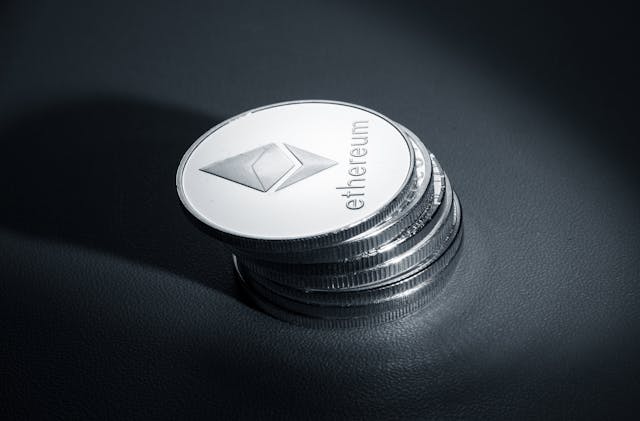Table of Contents
In the digital age, Decentralized Ledger Technology (DLT) has emerged as a revolutionary force, transforming various industries, and redefining how we perceive trust and security in the digital realm.
For cutting-edge insights and solutions in harnessing the power of Decentralized Ledger Technology (DLT), explore ethereum-eprex.com. At the forefront of this technological revolution is Ethereum, a groundbreaking platform that has gained immense popularity and influence in the world of DLT.
This article is a comprehensive guide that delves deep into Ethereum’s framework, shedding light on its origins, architecture, applications, and prospects.
The Birth of Ethereum

Background on Cryptocurrency and Bitcoin
To understand Ethereum fully, we must first revisit the inception of cryptocurrencies. Bitcoin, the world’s first cryptocurrency, introduced the concept of a decentralized, peer-to-peer digital currency, devoid of central control or intermediaries. This laid the foundation for Ethereum’s development, as it opened the door to exploring blockchain technology for broader purposes beyond currency.
Vitalik Buterin’s Vision for Ethereum
Ethereum was conceived by Vitalik Buterin, a visionary programmer and cryptocurrency enthusiast. In 2013, he published the Ethereum Whitepaper, outlining his vision for a blockchain platform that could support digital currency, smart contracts, and decentralized applications (DApps). This vision attracted widespread attention and set the stage for Ethereum’s creation.
Ethereum’s ICO and Launch
To fund the development of Ethereum, an Initial Coin Offering (ICO) was conducted in mid-2014, raising over $18 million in Bitcoin. Ethereum’s main net was subsequently launched in July 2015, marking the beginning of a new era in DLT. Ethereum quickly gained momentum and support from the global blockchain community.
Key Milestones in Ethereum’s Development
Since its inception, Ethereum has achieved several significant milestones. The Ethereum Virtual Machine (EVM) implementation enabled the execution of smart contracts, and Ethereum soon became the platform of choice for developers seeking to create DApps. Ethereum’s constant evolution led to the transition from Proof of Work (PoW) to Proof of Stake (PoS) consensus mechanism, addressing scalability and sustainability concerns.
Understanding Ethereum’s Architecture

Ethereum’s Blockchain Structure
Ethereum’s blockchain is a decentralized and distributed ledger that records all transactions and smart contracts. Unlike Bitcoin, Ethereum’s blockchain is not solely focused on monetary transactions. It can store and execute complex code, making it a versatile platform for various applications.
Smart Contracts and Their Role
Smart contracts are self-executing agreements with predefined rules and conditions. They automate processes, ensuring trust and transparency in transactions without the need for intermediaries. Ethereum’s smart contract capabilities have paved the way for numerous innovative applications across industries.
Ether (ETH) – The Native Cryptocurrency
Ether (ETH) is Ethereum’s native cryptocurrency, used to pay transaction fees and incentivize miners in the network. ETH plays a pivotal role in ensuring the security and functionality of the Ethereum ecosystem.
Gas Fees and Network Scalability
Transactions on the Ethereum network require a certain number of computational resources, measured in “gas.” Gas fees, denominated in ETH, compensate miners for their work and prevent network abuse. However, the high demand for Ethereum’s services has led to concerns about scalability, as gas fees can become exorbitant during periods of congestion.
Decentralized Applications (DApps) on Ethereum

Exploring the DApp Ecosystem
Ethereum’s open-source nature has fostered a thriving ecosystem of decentralized applications (DApps). These applications range from financial services to gaming, social networking, and more. DApps are built on Ethereum’s blockchain, benefiting from its security and reliability.
Popular Categories of DApps
Notable categories of DApps on Ethereum include DeFi (Decentralized Finance), NFTs (Non-Fungible Tokens), supply chain management, and identity verification. DeFi DApps provide decentralized lending, borrowing, and trading services, while NFTs have revolutionized the digital art and collectibles market.
Case Studies: Successful DApps on Ethereum
Examples of successful Ethereum-based DApps include Uniswap (a decentralized exchange), Aave (a lending platform), CryptoKitties (an NFT-based game), and OpenSea (an NFT marketplace). These projects have demonstrated the versatility and potential of Ethereum’s DApp ecosystem.
Challenges and Limitations of DApps
Despite their promise, DApps face challenges such as scalability issues, high gas fees, and regulatory uncertainties. Addressing these challenges will be crucial for the continued growth and adoption of DApps on Ethereum.
Ethereum’s Consensus Mechanism: Proof of Stake (PoS)

Transition from Proof of Work (PoW)
Ethereum’s transition from PoW to PoS, known as Ethereum 2.0 or Eth2.0, is a monumental shift aimed at improving scalability, security, and sustainability. PoS relies on validators who lock up ETH as collateral to participate in block validation, reducing energy consumption compared to PoW.
Benefits of PoS for Ethereum
PoS offers benefits such as reduced energy consumption, increased transaction throughput, and enhanced security. Eth2.0’s implementation introduces shard chains, further improving scalability by parallelizing transactions and smart contract execution.
The Beacon Chain and Shard Chains
The Beacon Chain, a PoS blockchain, went live as the first phase of Eth2.0 in December 2020. Shard chains, the next phase, will bring scalability improvements by dividing the network into smaller chains, each handling a portion of the workload.
Eth2.0 and Its Impact on Scalability
Ethereum 2.0’s full implementation is expected to address the scalability challenges that have hindered the network’s growth. This transition will make Ethereum more efficient and accessible to a broader range of users and applications.
Use Cases and Real-world Applications

Finance and DeFi on Ethereum
Ethereum has pioneered DeFi, a financial ecosystem that allows users to borrow, lend, trade, and earn interest on digital assets without intermediaries. This has opened up new possibilities for financial inclusion and innovation.
Non-fungible tokens (NFTs) and Digital Art
NFTs, unique digital assets that represent ownership of digital or physical items, have gained significant attention. Ethereum is the primary platform for NFT creation and trading, enabling artists, musicians, and creators to tokenize and monetize their work.
Supply Chain Management and Provenance
Ethereum’s transparency and immutability make it an ideal solution for supply chain management, providing a tamper-proof record of product origins, shipment details, and quality control.
Identity Verification and Personal Data Protection
Ethereum-based solutions for identity verification aim to give individuals control over their data. Users can grant access to specific information without exposing their entire identity.
Challenges and Future Developments

Scalability and Network Congestion
Ethereum’s ongoing challenges include addressing scalability issues to accommodate the growing demand for its services. Eth2.0’s full deployment is expected to alleviate these concerns.
Regulatory Concerns and Legal Challenges
Ethereum, like other cryptocurrencies, faces regulatory scrutiny in various jurisdictions. Navigating legal and compliance matters will be crucial for its long-term success.
Competition in the DLT Space
Ethereum faces competition from other blockchain platforms seeking to offer similar functionalities and address scalability issues. Maintaining its position as a leader in the DLT space will require continuous innovation.
Ethereum 2.0 and Beyond
The successful rollout of Eth2.0 will be a significant milestone for Ethereum, enhancing its capabilities and ensuring its relevance in the evolving DLT landscape. Beyond that, Ethereum’s future will be shaped by its ability to adapt to changing technology and market dynamics.
Conclusion
In conclusion, Ethereum’s decentralized ledger technology framework has transformed the digital landscape, providing a versatile platform for decentralized applications and innovative use cases. From its humble beginnings to its transition to Proof of Stake and beyond, Ethereum continues to evolve, addressing challenges and pushing the boundaries of what DLT can achieve. As Ethereum 2.0 unfolds and the DLT space matures, Ethereum’s influence is set to grow, impacting industries and reshaping the future of technology and finance.
Author Profile
- Blogger and Educator by Passion | Senior Online Media & PR Strategist at ClickDo Ltd. | Contributor to many Education, Business & Lifestyle Blogs in the United Kingdom & Germany | Summer Course Student at the London School of Journalism and Course Instructor at the SeekaHost University.
Latest entries
 FinanceMay 28, 2025Government Unveils Major Crackdown on Tax Avoidance – Up to £6.5 Billion Could Be Reclaimed by 2029
FinanceMay 28, 2025Government Unveils Major Crackdown on Tax Avoidance – Up to £6.5 Billion Could Be Reclaimed by 2029 FinanceApril 28, 2025Rising Tax Pressures Push Directors to Rethink Income Strategies for the New Tax Year
FinanceApril 28, 2025Rising Tax Pressures Push Directors to Rethink Income Strategies for the New Tax Year BusinessApril 7, 2025The Future of Leadership Development in the Remote Work Era
BusinessApril 7, 2025The Future of Leadership Development in the Remote Work Era Business StrategiesFebruary 13, 20254 Ways to Improve Your Brand’s Online Reputation
Business StrategiesFebruary 13, 20254 Ways to Improve Your Brand’s Online Reputation





